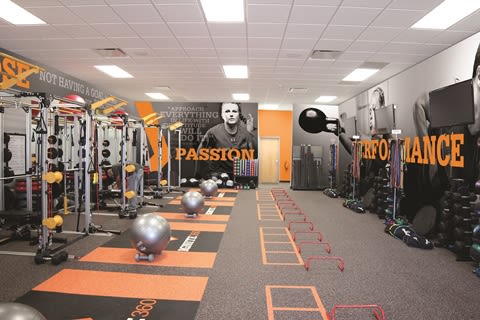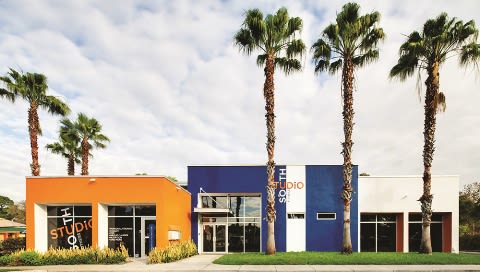The Body Business
Active baby boomers, a tight economy and increasing health care costs boost the region's fitness center industry.
By David Ball

On any given day, Sarasota’s workout addicts can be found pushing their bodies to the limits inside 2,000 square feet of space at Sarasota’s newest gym. There’s minimal use of machines and weights at IGNITE 360 Fitness, just a personal trainer barking commands and encouragement while sweat pours and muscles burn. Although it’s been open only since the beginning of October, business looks brisk.
IGNITE 360 is part of Bradenton’s IMG Academy, and this is the international sports center’s first time bringing a version of its elite and private athlete training program (some of the same training its tennis stars and NFL and NBA clients use) to the public.
IGNITE’s users range from teens to 60-somethings, and they tend to be people who are always on the prowl for the latest fitness trend.
“I’ve tried it all,” says Susan Roney Asselstine, 54, a certified personal trainer in Sarasota and one of IGNITE 360’s first members. “IMG has figured out a way to train the top athletes from around the country to maximize their performance, making them the best at what they do, and now they have created a way for a regular person like me to get those same benefits. I may not be the best athlete, but I get to be the best at what I do.”

IMG thinks there are lots more like Asselstine in the market. While IMG officials say the move was mostly to bolster their brand and reach into the community, they see a local fitness market that, like the nation’s, is growing stronger.
“We did it because was there was a demand for it,” says Brian Griffin, IMG’s vice president in charge of IGNITE 360. “Our game plan here is to open this one, then to open up another one here in this community and then open up another one and get to the point where we might have three or four of these places right here in town.”
Griffin has reason to be confident. Across the country, the number of health clubs has risen 3 percent since 2008 to 30,500, while memberships have climbed 10 percent to 51.3 million people, according to the International Health, Racquet and Sports Club Association. In all, it represents a $21.8-billion industry. What’s more, the U.S. Department of Labor projects employment of fitness instructors and trainers will grow 24 percent from 2010 to 2020. Florida has the fourth most fitness jobs in the country.

Locally, the market is harder to quantify, but the Department of Labor does estimate some 810 fitness-related jobs in the North Port-Sarasota-Bradenton survey area in 2012. Our region is also more saturated with fitness jobs than both the state and national average, with more than three related jobs per 1,000 total jobs. The state and national average is 1.8 jobs per 1,000.
A quick Google search shows about 120 gyms and fitness centers in the two-county area, made up of independent businesses and franchise chains like LA Fitness, Orangetheory Fitness, Curves and Pure Barre, as well as affiliate operators of branded workouts like CrossFit. That also doesn’t include YMCAs, martial arts studios and private in-home trainers.
How to stay competitive in this market is a challenge. With 11,000 members whose ages span nearly a century, the Sarasota Family YMCA serves a diverse membership in its three fitness centers, which have been operating for decades. CEO Kurt Stringfellow says the biggest trend now is that everyone is becoming more health conscious, so the Y offers activities for every age group. In particular, baby boomers and seniors, who make up about 40 percent of the Y’s members, want to maintain their health, so the Y has started classes such as aqua cycling to serve aging members.
“When there is more competition, it forces us to raise the bar, and the consumer wins,” he says.
Still, fitness insiders say even with a highly fragmented and competitive market, there’s room for new players if they find a niche—not a fad—and do their homework.
At IGNITE 360, the business model is based on IMG-certified trainers leading customers through a specially developed fitness routine.
Griffin says about 180 customers signed up in less than a month, mostly for monthly or annual memberships, which “are good signs because it means there’s a little more commitment,” he says. Because the gym utilizes very little equipment, IMG’s initial investment was low and Griffin expects to turn a profit easily within the first year—rare for new gyms. Fees range from $20 a class to membership rates of $159 a month to $1,599 a year. IMG’s affiliation with sponsors like Gatorade and Under Armour means IGNITE can negotiate low costs on equipment and products. Griffin says it will take several years of continued success before the venture expands into possible franchises.

Another newcomer in the local market, however, started by one of the area’s leading franchise gurus, wants to turn its fitness niche into a multibillion-dollar empire.
Sarasota’s Jim Abrams describes his latest venture, Fyzical, as a rehab and physical therapy center that will also offer fitness as a core component. Its business model focuses on medically based fitness regimes taught by licensed physical therapists. Abrams says today’s demographics and savvy consumers demonstrate the market potential.
“You have a generation coming right now that’s moving into retirement, and they are a very active group of people,” Abrams says. “On the younger level, America has gone through this economic crisis of the last decade and fitness is something anybody can do relatively inexpensively.”
Abrams adds that the growing health care crisis will also continue to drive growth in fitness. He says, “I think you’re going to see a continued trend in this direction simply because of the new information becoming available and the cost to the American health care community.”
Abrams, who had a hand in starting Weight Watchers and sold his last franchise company, Clockwork Home Services, for $183 million in 2010, expects even bigger results with Fyzical. The first location opened in February, and he expects sales between $10 million and $15 million by the end of the year and $80 million by the end of 2014. The goal is for 1,000 locations and $3 billion in sales by the end of the decade.
Nationally, gyms and fitness centers are dominated by chains and franchises, which make up more than 50 percent of the market, according to the trade group IHRSA. However, even these fitness behemoths are moving away from big-box facilities with rows of treadmills and weights and heading towards niche clubs located closer to neighborhoods where customers can stop in for a quick workout on their way to and from work. Clubs are also staying open later and marketing to specific demographics.
“A lot of growth has come from niche-specific clubs, whether age-specific or sports-specific,” says Meredith Poppler, IHRSA vice president for industry growth. “Niche clubs as well as the 24-hour key clubs are able to open in a much smaller space, often with lower overhead than the traditional multipurpose club. Another quickly growing club concept [is] the very affordable chains where dues are $20 a month or even less.”

But while a business needs a niche, it shouldn’t be tied to a fitness trend or fad like a miracle diet or a very specific type of workout, says Tiffany Liashek, who opened Studio South Fitness in Sarasota in early 2013.
“I think some of these small facilities pop up because they figure the fad is the next big thing,” Liashek says. “They have their place, but it’s usually only for a five- or seven-year run. The reason the big boxes outlast is what they have works.”
Liashek said she studied the local market extensively before deciding on a business model that focused on the high-end market with resort-level fitness classes and trainers. She identified 26 competing small fitness studios in her location near downtown, which she chose because of its proximity to the affluent West of Trail neighborhood and seasonal markets of Longboat and Siesta keys.
“We felt there was a lack in the market for what we offer,” says Liashek, who adds that she ruled out a franchise business early on. “I didn’t like that I had to continue to pay royalties. I march to the beat of my own drum, and I like that I can change things as I want.”
Liashek decided not to hire trainers on staff but instead hire them as independent contractors and take a cut of their fees when they train clients in her facility. She has grown from five to 12 trainers since opening to meet the customer demand, though she likely won’t see a profit until next year. Equipment purchases and location build-out, along with extensive early advertising and marketing, led to a high initial investment. Her expected $500,000 in revenues this year won’t allow her to break even, though revenues were higher than she anticipated for her first year and leave her optimistic for the future.
“A 20-percent profit margin is a realistic number if you do it right,” Liashek says. “This is a very healthy area for the most part, and people work out and they love what they do. The nice thing about Sarasota is that even with as many facilities as there are, there are still many more clients to go around.”